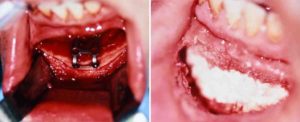Background: The sliding genioplasty is a well known autogenous chin augmentation procedure. When contrasted to that of a chin implant, it has advantages and disadvantages to the alloplastic alternative. Which chin augmentation approach is best for any patient must be decided on an individual basis. Suffice it to say two different chin augmentation techniques exist since neither one is perfect for every patient’s aesthetic chin needs.
One feature of any horizontal chin augmentation procedure is that the depth of the labiomental fold will not be improved and may even get deeper. This is expected as the attachment of the mentalis muscle to the bone, which is the anatomic basis for the presence of the fold, does not change. The down fractured chin segment from a sliding genioplasty is done below the level of the muscle attachment. (even though the muscle must be cut and then reattached to perform the procedure) Thus as the chin comes forward the labiomental fold attachment remains the same. By definition this can make the labiodental fold look perceptibly deeper. Whether his usually negative aesthetic effect will be significant depends on how much chin advancement is done.
In lowering the risk of labiomental fold deepening with a sliding genioplasty, the bone step-off can be filled in with a variety of materials. This is particularly relevant when the chin advancement becomes considerable. There are a variety of alloplastic and allogeneic materials from which to choose.
Case Study: This 15 year-old male had a short chin although an orthodontically corrected Class I occlusion. Given his young age and the degree of horizontal chin advancement needed, a sliding genioplasty procedure was chosen.


Hydroxyapatite bone cement is one option for augmenting the underlying bony step-off in a sliding genioplasty. Its only limiting factor is its cost.
Highlights:
- The sliding genioplasty moves the bottom portion of the chin bone forward but leaves the superior portion of the bone and the labiomentall fold behind.
- The bony step off of the sliding genioplasty can be augmented or filled in with a variety of materials.
- Grafting the step off in the advanced chin can help soften any deepening of the labiodental fold.
Dr. Barry Eppley
Indianapolis, Indiana


